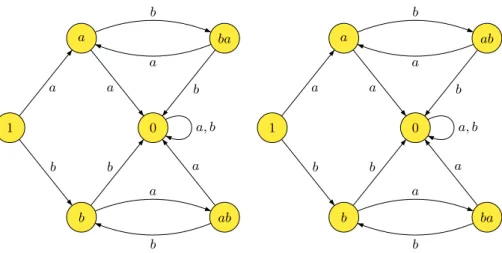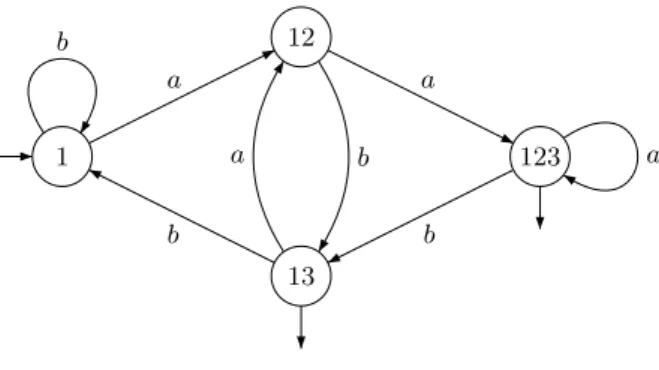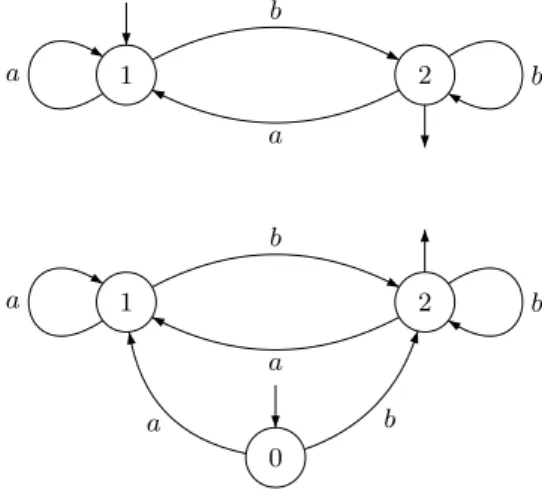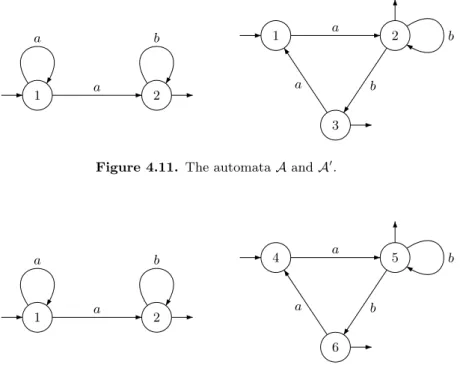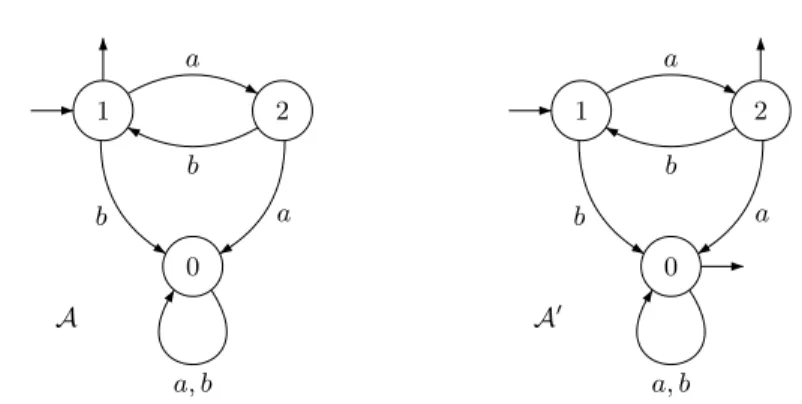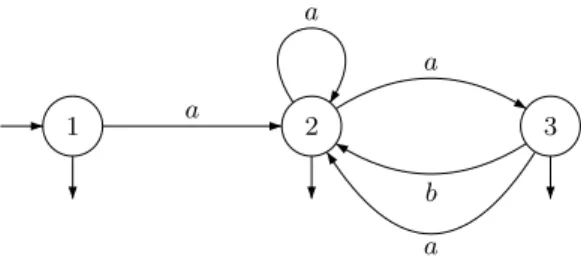Mathematical Foundations of Automata Theory
Jean-´Eric Pin
Version of December 2, 2020
Preface
These notes form the core of a future book on the algebraic foundations of automata theory. This book is still incomplete, but the first eleven chapters now form a relatively coherent material, covering roughly the topics described below.
The early years of automata theory
Kleene’s theorem [68] is usually considered as the starting point of automata theory. It shows that the class of recognisable languages (that is, recognised by finite automata), coincides with the class of rational languages, which are given by rational expressions. Rational expressions can be thought of as a generalisation of polynomials involving three operations: union (which plays the role of addition), product and the star operation. It was quickly observed that these essentially combinatorial definitions can be interpreted in a very rich way in algebraic and logical terms. Automata over infinite words were introduced by B¨uchi in the early 1960’s to solve decidability questions in first-order and monadic second-order logic of one successor. Investigating two-successor logic, Rabin was led to the concept of tree automata, which soon became a standard tool for studying logical definability.
The algebraic approach
The definition of thesyntactic monoid, a monoid canonically attached to each language, was first given by Sch¨utzenberger in 1956 [137]. It later appeared in a paper of Rabin and Scott [128], where the notion is credited to Myhill. It was shown in particular that a language is recognisable if and only if its syn- tactic monoid is finite. However, the first classification results on recognisable languages were rather stated in terms of automata [88] and the first nontrivial use of the syntactic monoid is due to Sch¨utzenberger [138]. Sch¨utzenberger’s theorem (1965) states that a rational language is star-free if and only if its syn- tactic monoid is finite and aperiodic. This elegant result is considered, right after Kleene’s theorem, as the most important result of the algebraic theory of automata. Sch¨utzenberger’s theorem was supplemented a few years later by a result of McNaughton [83], which establishes a link between star-free languages and first-order logic of the order relation.
Both results had a considerable influence on the theory. Two other important algebraic characterisations date back to the early seventies: Simon [141] proved that a rational language is piecewise testable if and only if its syntactic monoid is J-trivial and Brzozowski-Simon [23] and independently, McNaughton [82]
3
4
characterised the locally testable languages. The logical counterpart of the first result was obtained by Thomas [163]. These successes settled the power of the algebraic approach, which was axiomatized by Eilenberg in 1976 [42].
Eilenberg’s variety theory
A variety of finite monoids is a class of monoids closed under taking submonoids, quotients and finite direct products. Eilenberg’s theorem states that varieties of finite monoids are in one-to-one correspondence with certain classes of recognis- able languages, the varieties of languages. For instance, the rational languages are associated with the variety of all finite monoids, the star-free languages with the variety of finite aperiodic monoids, and the piecewise testable languages with the variety of finiteJ-trivial monoids. Numerous similar results have been es- tablished over the past thirty years and, for this reason, the theory of finite automata is now intimately related to the theory of finite monoids.
Several attempts were made to extend Eilenberg’s variety theory to a larger scope. For instance, partial order on syntactic semigroups were introduced in [98], leading to the notion of ordered syntactic semigroups. The resulting exten- sion of Eilenberg’s variety theory permits one to treat classes of languages that are not necessarily closed under complement, contrary to the original theory.
Other extensions were developed independently by Straubing [157] and ´Esik and Ito [45].
The topological point of view
Due allowance being made, the introduction of topology in automata theory can be compared to the use ofp-adic analysis in number theory.
The notion of a variety of finite monoids was coined after a similar notion, introduced much earlier by Birkhoff for infinite monoids: a Birkhoff variety of monoidsis a class of monoids closed under taking submonoids, quotient monoids and direct products. Birkhoff proved in [15] that his varieties can be defined by a set of identities: for instance the identity xy =yx characterises the variety of commutative monoids. Almost fifty years later, Reiterman [130] extended Birkhoff’s theorem to varieties of finite monoids: any variety of finite monoids can be characterised by a set of profinite identities. A profinite identity is an identity between two profinite words. Profinite words can be viewed as limits of sequences of words for a certain metric, the profinite metric. For instance, one can show that the sequence xn! converges to a profinite word denoted by xω and the variety of finite aperiodic monoids can be defined by the identity xω=xω+1.
The profinite approach is not only a powerful tool for studying varieties but it also led to unexpected developments, which are at the heart of the current research in this domain. In particular, Gehrke, Grigorieff and the author [47]
proved that any lattice of recognisable languages can be defined by a set of profinite equations, a result that subsumes Eilenberg’s variety theorem.
The logical approach
We already mentioned B¨uchi’s, Rabin’s and McNaughton’s remarkable results on the connection between logic and finite automata. B¨uchi’ssequential calculus
5 is a logical language to express combinatorial properties of words in a natural way. For instance, properties like “a word contains two consecutive occurrences ofa” or “a word of even length” can be expressed in this logic. However, several parameters can be adjusted. Different fragments of logic can be considered:
first-order, monadic second-order, Σn-formulas and a large variety of logical and nonlogical symbols can be employed.
There is a remarkable connection between first-order logic and the concate- nation product. The polynomial closure of a class of languagesL is the set of languages that are sums of marked products of languages ofL. By alternating Boolean closure andpolynomial closure, one obtains a natural hierarchy of lan- guages. The level 0 is the Boolean algebra {∅, A∗}. Next, for each n>0, the level 2n+ 1 is the polynomial closure of the level 2nand the level 2n+ 2 is the Boolean closure of the level 2n+ 1. A very nice result of Thomas [163] shows that a recognisable language is of level 2n+ 1 in this hierarchy if and only if it is definable by a Σn+1-sentence of first-order logic in the signature{<,(a)a∈A}, wherea is a predicate giving the positions of the lettera.
There are known algebraic characterisations for the three first levels of this hierarchy. In particular, the second level is the class of piecewise testable lan- guages characterised by Simon [140].
Contents of these notes
The algebraic approach to automata theory relies mostly on semigroup theory, a branch of algebra which is usually not part of the standard background of a student in mathematics or in computer science. For this reason, an important part of these notes is devoted to an introduction to semigroup theory. ChapterII gives the basic definitions and ChapterVpresents the structure theory of finite semigroups. ChaptersXVIandXVIIIintroduce some more advanced tools, the relational morphisms and the semidirect and wreath products.
Chapter IIIgives a brief overview on finite automata and recognisable lan- guages. It contains in particular a complete proof of Kleene’s theorem which relies on Glushkov’s algorithm in one direction and on linear equations in the opposite direction. For a comprehensive presentation of this theory I recom- mend the book of my colleague Jacques Sakarovitch [135]. The recent book of Olivier Carton [27] also contains a nice presentation of the basic properties of finite automata. Recognisable and rational subsets of a monoid are pre- sented in ChapterIV. The notion of a syntactic monoid is the key notion of this chapter, where we also discuss the ordered case. ChaptersVIand VII present two major results, at the core of the algebraic approach to automata theory:
Sch¨utzenberger’s and Simon’s theorem. The profinite topology is introduced in Chapter X. We start with a short synopsis on general topology and metric spaces and then discuss the relationship between profinite topology and recog- nisable languages. Chapter XIis devoted to varieties of finite monoids and to Reiterman’s theorem. It also contains a large collection of examples. Chapter XIIpresents the equational characterisation of lattices of languages. Eilenberg’s variety theory forms the topic of ChapterXIII. Examples of application of these two results are gathered in ChapterXIV. The last five chapters are still under construction. ChapterXVis about polynomial closure, ChapterXVIIpresents another deep result of Sch¨utzenberger about unambiguous star-free languages and its logical counterpart. ChapterXIXgives a brief introduction to sequential
6
functions and the wreath product principle. Chapter IXpresents some logical descriptions of languages and their algebraic characterisations.
Notation and terminology
The termregular set is frequently used in the literature but there is some con- fusion on its interpretation. In Ginzburg [51] and in Hopcroft, Motwani and Ullman [62], a regular set is a set of words accepted by a finite automaton. In Salomaa [136], it is a set of words defined by a regular grammar and in Car- oll and Long [26], it is a set defined by a regular expression. This is no real problem for languages, since, by Kleene’s theorem, these three definitions are equivalent. This is more problematic for monoids in which Kleene’s theorem does not hold. Another source of confusion is that the termregular has a well- established meaning in semigroup theory. For these reasons, I prefer to use the termsrecognisable andrational.
I tried to keep some homogeneity in notation. Most of the time, I use Greek letters for functions, lower case letters for elements, capital letters for sets and calligraphic letters for sets of sets. Thus I write: “let s be an element of a semigroupS and letP(S) be the set of subsets ofS”. I write functions on the left and transformations and actions on the right. In particular, I denote byq·u the action of a word u on a state q. Why so many computer scientists prefer the awful notation δ(q, u) is still a mystery. It leads to heavy formulas, like δ(δ(q, u), v) =δ(q, uv), to be compared to the simple and intuitive (q·u)·v = q·uv, for absolutely no benefit.
I followed Eilenberg’s tradition to use boldface letters, like V, to denote varieties of semigroups, and to use calligraphic letters, like V, for varieties of languages. However, I have adopted Almeida’s suggestion to have a different notation for operators on varieties, likeEV,LVor PV.
I use the term morphism for homomorphism. Semigroups are usually de- noted byS or T, monoids byM or N, alphabets areA or B and letters by a, b, c, . . . but this notation is not frozen: I may also useA for semigroup and S for alphabet if needed! Following a tradition in combinatorics,|E| denotes the number of elements of a finite set. The notation|u| is also used for the length of a wordu, but in practice, there is no risk of confusion between the two.
To avoid repetitions, I frequently use brackets as an equivalent to “respec- tively”, like in the following sentence : a semigroup [monoid, group]S is com- mutative if, for allx, y∈S,xy=yx.
Lemmas, propositions, theorems and corollaries share the same counter and are numbered by section. Examples have a separate counter, but are also num- bered by section. References are given according to the following example:
Theorem 1.6, Corollary 1.5 and Section 1.2 refer to statements or sections of the same chapter. Proposition X.3.16refers to a proposition which is external to the current chapter.
Acknowledgements
Several books on semigroups helped me in preparing these notes. Clifford and Preston’s treatise [30, 31] remains the classical reference. My favourite source for the structure theory is Grillet’s remarkable presentation [55]. I also borrowed a lot from the books by Almeida [4], Eilenberg [42], Higgins [60], Lallement [76]
7 and Lothaire [78] and also of course from my own books [95, 90]. Another source of inspiration (not yet fully explored!) are the research articles by my colleagues Jorge Almeida, Karl Auinger, Jean-Camille Birget, Olivier Carton, Mai Gehrke, Victor Guba, Rostislav Horˇc´ık, John McCammond, Stuart W.
Margolis, Dominique Perrin, Mark Sapir, Imre Simon, Ben Steinberg, Howard Straubing, Pascal Tesson, Denis Th´erien, Misha Volkov, Pascal Weil and Marc Zeitoun.
I would like to thank my former Ph.D. students Laure Daviaud, Luc Dar- tois, Charles Paperman and Yann Pequignot, my colleagues at IRIF and LaBRI and my former students of the Master Parisien de Recherches en Informatique (notably Aiswarya Cyriac, Nathana¨el Fijalkow, Agnes K¨ohler, Arthur Milchior, Anca Nitulescu, Pierre Pradic, L´eo Stefanesco, Amrita Suresh, Boker Udi, Jill- Jˆenn Vie and Furcy) for pointing out many misprints and corrections on ear- lier versions of this document. I would like to acknowledge the assistance and the encouragements of my colleagues of the Picasso project, Adolfo Ballester- Bolinches, Antonio Cano G´omez, Ramon Esteban-Romero, Xaro Soler-Escriv`a, Maria Bel´en Soler Monreal, Jorge Palanca and of the Pessoa project, Jorge Almeida, M´ario J. J. Branco, V´ıtor Hugo Fernandes, Gracinda M. S. Gomes and Pedro V. Silva. Other careful readers include Achim Blumensath and Martin Beaudry (with the help of his student C´edric Pinard) who proceeded to a very careful reading of the manuscript. George Hansoul, Alfonso Labao, S´ebastien Labb´e, Nathan Lothe, Anne Schilling, Manon Stipulanti and Herbert Toth sent me some very useful remarks. Special thanks are due to Jean Berstel and to Paul Gastin for providing me with their providential LATEX packages.
Paris, December 2020 Jean-´Eric Pin
Contents
A Automata and semigroups 1
I Algebraic preliminaries. . . . 3
1 Subsets, relations and functions . . . . 3
1.1 Sets . . . . 3
1.2 Relations . . . . 3
1.3 Functions . . . . 4
1.4 Injective and surjective relations . . . . 6
1.5 Relations and set operations . . . . 8
2 Ordered sets . . . . 9
3 Exercises . . . . 10
II Semigroups and beyond . . . . 13
1 Semigroups, monoids and groups . . . . 13
1.1 Semigroups, monoids . . . . 13
1.2 Special elements . . . . 14
1.3 Groups . . . . 15
1.4 Ordered semigroups and monoids . . . . 16
1.5 Semirings . . . . 16
2 Examples . . . . 16
2.1 Examples of semigroups . . . . 17
2.2 Examples of monoids . . . . 17
2.3 Examples of groups . . . . 18
2.4 Examples of ordered monoids . . . . 18
2.5 Examples of semirings . . . . 18
3 Basic algebraic structures . . . . 19
3.1 Morphisms . . . . 19
3.2 Subsemigroups . . . . 20
3.3 Quotients and divisions . . . . 21
3.4 Products . . . . 22
3.5 Ideals . . . . 22
3.6 Simple and 0-simple semigroups . . . . 24
3.7 Semigroup congruences . . . . 24
4 Transformation semigroups . . . . 27
4.1 Definitions . . . . 27
4.2 Full transformation semigroups and symmetric groups . . . 28
4.3 Product and division . . . . 28
5 Generators . . . . 29 i
ii CONTENTS
5.1 A-generated semigroups . . . . 29
5.2 Cayley graphs . . . . 29
5.3 Free semigroups . . . . 30
5.4 Universal properties . . . . 30
5.5 Presentations and rewriting systems . . . . 31
6 Idempotents in finite semigroups . . . . 32
7 Exercises . . . . 35
III Languages and automata . . . . 37
1 Words and languages . . . . 37
1.1 Words . . . . 37
1.2 Orders on words . . . . 38
1.3 Languages . . . . 38
2 Rational languages . . . . 40
3 Automata . . . . 42
3.1 Finite automata and recognisable languages . . . . 42
3.2 Deterministic automata . . . . 45
3.3 Complete, accessible, coaccessible and trim automata . . . 47
3.4 Standard automata . . . . 48
4 Operations on recognisable languages . . . . 48
4.1 Boolean operations . . . . 49
4.2 Product . . . . 51
4.3 Star . . . . 52
4.4 Quotients . . . . 54
4.5 Inverses of morphisms . . . . 55
4.6 Minimal automata . . . . 55
5 Rational versus recognisable . . . . 58
5.1 Local languages . . . . 58
5.2 Glushkov’s algorithm . . . . 61
5.3 Linear equations . . . . 64
5.4 Extended automata . . . . 67
5.5 Kleene’s theorem . . . . 69
6 Exercises . . . . 70
7 Notes . . . . 73
IV Recognisable and rational sets . . . . 75
1 Rational subsets of a monoid . . . . 75
2 Recognisable subsets of a monoid . . . . 77
2.1 Recognition by monoid morphisms . . . . 77
2.2 Operations on sets . . . . 79
2.3 Recognisable sets . . . . 80
3 Connection with automata . . . . 83
3.1 Transition monoid of a deterministic automaton . . . . 83
3.2 Transition monoid of a nondeterministic automaton . . . . 85
3.3 Monoids versus automata . . . . 86
4 The syntactic monoid . . . . 88
4.1 Definitions . . . . 88
4.2 The syntactic monoid of a language . . . . 90
4.3 Computation of the syntactic monoid of a language . . . . 91
CONTENTS iii
5 Recognition by ordered structures . . . . 91
5.1 Ordered automata . . . . 91
5.2 Recognition by ordered monoids . . . . 92
5.3 Syntactic order . . . . 93
5.4 Computation of the syntactic ordered monoid . . . . 93
6 Exercises . . . . 95
7 Notes . . . . 97
V Green’s relations and local theory. . . . 99
1 Green’s relations . . . . 99
2 Inverses, weak inverses and regular elements . . . . 107
2.1 Inverses and weak inverses . . . . 107
2.2 Regular elements . . . . 109
3 Rees matrix semigroups . . . . 110
4 Structure of regular D-classes . . . . 116
4.1 Structure of the minimal ideal . . . . 117
5 Green’s relations in subsemigroups and quotients . . . . 117
5.1 Green’s relations in subsemigroups . . . . 118
5.2 Green’s relations in quotient semigroups . . . . 119
6 Green’s relations and transformations . . . . 121
7 Summary: a complete example . . . . 124
8 Exercises . . . . 126
9 Notes . . . . 128
B Historical results 129 VI Star-free languages . . . . 131
1 Star-free languages . . . . 131
2 Aperiodic monoids . . . . 132
3 Sch¨utzenberger’s theorem . . . . 132
4 Exercises . . . . 137
5 Notes . . . . 137
VII Piecewise testable languages . . . . 139
1 Subword ordering . . . . 139
2 Simple languages and shuffle ideals . . . . 143
3 Piecewise testable languages and Simon’s theorem . . . . 144
4 Some consequences of Simon’s theorem . . . . 146
5 Exercises . . . . 148
6 Notes . . . . 149
VIII Locally testable languages . . . . 151
1 Scanners . . . . 151
2 A congruence on words . . . . 152
3 Path conditions . . . . 152
4 An algebraic characterization . . . . 154
5 Notes . . . . 155
iv CONTENTS
IX An excursion into logic . . . . 157
1 Introduction . . . . 157
2 The formalism of logic . . . . 157
2.1 Syntax . . . . 157
2.2 Semantics . . . . 160
2.3 Logic on words . . . . 163
3 Monadic second-order logic on words . . . . 165
4 First-order logic of the linear order . . . . 168
4.1 First order and star-free sets . . . . 169
4.2 Σ1 formulas and piecewise testable languages . . . . 170
5 Exercises . . . . 170
6 Notes . . . . 171
C The profinite world 173 X Profinite words . . . . 175
1 Topology . . . . 175
1.1 General topology . . . . 175
1.2 Metric spaces . . . . 176
1.3 Compact spaces . . . . 177
1.4 Topological semigroups . . . . 178
2 Profinite topology . . . . 178
2.1 The profinite metric . . . . 178
2.2 The free profinite monoid . . . . 181
2.3 Universal property of the free profinite monoid . . . . 183
2.4 ω-terms . . . . 184
3 Recognisable languages and clopen sets . . . . 185
4 Exercises . . . . 188
5 Notes . . . . 188
XI Varieties . . . . 189
1 Varieties . . . . 189
2 Free pro-Vmonoids . . . . 190
3 Identities . . . . 193
3.1 What is an identity? . . . . 193
3.2 Properties of identities . . . . 194
3.3 Reiterman’s theorem . . . . 194
4 Examples of varieties . . . . 196
4.1 Varieties of semigroups . . . . 196
4.2 Varieties of monoids . . . . 199
4.3 Varieties of ordered monoids . . . . 204
4.4 Summary . . . . 204
5 Exercises . . . . 205
6 Notes . . . . 207
CONTENTS v
XII Equations and languages. . . . 209
1 Equations . . . . 209
2 Equational characterisation of lattices . . . . 210
3 Lattices of languages closed under quotients . . . . 212
4 Equational descriptions of lattices of languages . . . . 213
4.1 The role of the zero . . . . 213
4.2 Languages defined by density . . . . 216
5 Exercises . . . . 221
6 Notes . . . . 222
XIII Eilenberg’s variety theory . . . . 223
1 Streams of languages . . . . 223
2 C-streams . . . . 224
3 Varieties of languages . . . . 226
4 The variety theorem . . . . 226
5 Summary . . . . 230
6 Notes . . . . 230
XIV Algebraic characterisations . . . . 231
1 Varieties of languages . . . . 231
1.1 Locally finite varieties of languages . . . . 231
1.2 Commutative languages . . . . 234
1.3 R-trivial and L-trivial languages . . . . 236
1.4 Some examples of +-varieties . . . . 238
1.5 Cyclic and strongly cyclic languages . . . . 240
2 Exercises . . . . 246
3 Notes . . . . 247
D Advanced tools 249 XV Polynomial closure . . . . 251
1 Polynomial closure of a lattice of languages . . . . 251
2 A case study . . . . 256
XVI Relational morphisms. . . . 257
1 Relational morphisms . . . . 257
2 Injective relational morphisms . . . . 259
3 Relational V-morphisms . . . . 260
3.1 Aperiodic relational morphisms . . . . 261
3.2 Locally trivial relational morphisms . . . . 262
3.3 RelationalJese6eK-morphisms . . . . 263
4 Four examples of V-morphisms . . . . 264
5 Mal’cev products . . . . 264
6 Three examples of relational morphisms . . . . 265
6.1 Concatenation product . . . . 265
6.2 Pure languages . . . . 267
6.3 Flower automata . . . . 269
vi CONTENTS
XVII Unambiguous star-free languages . . . . 271
1 Unambiguous star-free languages . . . . 271
XVIIIWreath product . . . . 273
1 Semidirect product . . . . 273
2 Wreath product . . . . 273
3 Basic decomposition results . . . . 275
4 Exercises . . . . 280
XIX Sequential functions. . . . 281
1 Definitions . . . . 281
1.1 Pure sequential transducers . . . . 281
1.2 Sequential transducers . . . . 284
2 Composition of sequential functions . . . . 285
3 Sequential functions and wreath product . . . . 289
4 The wreath product principle and its consequences . . . . 290
4.1 The wreath product principle . . . . 290
5 Applications of the wreath product principle . . . . 291
5.1 The operationsT 7→U1◦T andL7→LaA∗ . . . . 291
5.2 The operationsT 7→¯2◦T andL7→La . . . . 292
5.3 The operationT 7→U2◦T and star-free expressions . . . . 294
6 Exercises . . . . 295
XX Concatenation hierarchies . . . . 297
1 Concatenation hierarchies . . . . 297
2 Logical hierarchy . . . . 299
Annex 305 A A transformation semigroup . . . . 307
References. . . . 311
Index . . . . 324
Part A
Automata and semigroups
1
Chapter I
Algebraic preliminaries
1 Subsets, relations and functions
1.1 Sets
The set of subsets of a set E is denoted by P(E) (or sometimes 2E). The positive Boolean operations on P(E) comprise union and intersection. The Boolean operationsalso includecomplementation. The complement of a subset X of E is denoted by Xc. Thus, for all subsets X and Y of E, the following relations hold
(Xc)c=X (X∪Y)c=Xc∩Yc (X∩Y)c=Xc∪Yc
We let|E|denote the number of elements of a finite setE, also called thesize ofE. Asingletonis a set of size 1. We shall frequently identify a singleton {s}
with its unique elements.
Given two setsE andF, the set of ordered pairs (x, y) such thatx∈E and y∈F is writtenE×F and called theproductofE andF.
1.2 Relations
Let E and F be two sets. A relation on E and F is a subset of E ×F. If E =F, it is simply called arelation on E. A relation τ can also be viewed as a function1 fromE toP(F) by setting, for each x∈E,
τ(x) ={y∈F |(x, y)∈τ}
By abuse of language, we say thatτ is a relation fromEto F.
Theinverse of a relationτ⊆E×F is the relationτ−1⊆F×E defined by τ−1={(y, x)∈F×E|(x, y)∈τ}
Note that ifτ is a relation fromE inF, the relationτ−1can be also viewed as a function fromF toP(E) defined by
τ−1(y) ={x∈E|y∈τ(x)}
1Functions are formally defined in the next section, but we assume the reader is already familiar with this notion.
3
4 CHAPTER I. ALGEBRAIC PRELIMINARIES A relation from E to F can be extended to a function fromP(E) toP(F) by setting, for each subsetX ofE,
τ(X) = [
x∈X
τ(x) ={y∈F |for some x∈X, (x, y)∈τ}
IfY is a subset ofF, we then have τ−1(Y) = [
y∈Y
τ−1(y) ={x∈E |there existsy∈Y such that y∈τ(x)}
={x∈E|τ(x)∩Y 6=∅}
Given two relations τ1 :E →F and τ2 :F →G, we letτ1τ2 or τ2◦τ1 denote thecompositionofτ1 andτ2, which is the relation fromE toGdefined by
(τ2◦τ1)(x) ={z∈G|there existsy∈F such thaty∈τ1(x) andz∈τ2(y)}
1.3 Functions
A [partial] function ϕ : E →F is a relation on E and F such that for every x∈E, there exists one and only one [in the case of a partial function, at most one] element y ∈F such that (x, y)∈ϕ. When this y exists, it is denoted by ϕ(x). The set
Dom(ϕ) ={x∈E|there exists y∈F such that (x, y)∈ϕ}
is called thedomainofϕ. A function with domainE is sometimes called atotal functionor amappingfrom Eto F. The set
Im(ϕ) ={y∈F |there existsx∈E such that (x, y)∈ϕ}
is called the rangeor theimage of ϕ. Given a set E, the identity mapping on E is the mapping IdE:E→E defined by IdE(x) =xfor allx∈E.
A mappingϕ:E→F is calledinjectiveif, for everyu, v∈E,ϕ(u) =ϕ(v) implies u = v. It is surjective if, for every v ∈ F, there exists u ∈ E such thatv∈ϕ(u). It isbijective if it is simultaneously injective and surjective. For instance, the identity mapping IdE(x) is bijective.
Proposition 1.1. Let ϕ: E → F be a mapping. Then ϕ is surjective if and only if there exists a mapping ψ:F →E such that ϕ◦ψ= IdF.
Proof. If there exists a mappingψ with these properties, we haveϕ(ψ(y)) =y for ally∈F and thusϕis surjective. Conversely, suppose that ϕis surjective.
For each element y ∈ F, select an element ψ(y) in the nonempty set ϕ−1(y).
This defines a mappingψ:F →E such thatϕ◦ψ(y) =y for ally∈F. A consequence of Proposition 1.1is that surjective maps are right cancellative (the definition of a right cancellative map is transparent, but if needed, a formal definition is given in SectionII.1.2).
Corollary 1.2. Let ϕ:E→F be a surjective mapping and letαandβ be two mappings from F toG. Ifα◦ϕ=β◦ϕ, thenα=β.
1. SUBSETS, RELATIONS AND FUNCTIONS 5 Proof. By Proposition1.1, there exists a mappingψ:F →E such thatϕ◦ψ= IdF. Thereforeα◦ϕ=β◦ϕimpliesα◦ϕ◦ψ=β◦ϕ◦ψ, whenceα=β.
Proposition 1.3. Let ϕ : E → F be a mapping. Then ϕ is injective if and only if there exists a mapping ψ: Im(ϕ)→E such thatψ◦ϕ= IdE.
Proof. Suppose there exists a mapping ψ with these properties. Then ϕ is injective since the condition ϕ(x) =ϕ(y) impliesψ◦ϕ(x) =ψ◦ϕ(y), that is, x=y. Conversely, suppose thatϕis injective. Define a mappingψ: Im(ϕ)→E by settingψ(y) = x, where x is the unique element ofE such thatϕ(x) = y.
Thenψ◦ϕ= IdE by construction.
It follows that injective maps areleft cancellative.
Corollary 1.4. Let ϕ:F →Gbe an injective mapping and letαandβ be two mappings from E toF. Ifϕ◦α=ϕ◦β, then α=β.
Proof. By Proposition 1.3, there exists a mapping ψ : Im(ϕ) → F such that ψ◦ϕ= IdF. Therefore ϕ◦α=ϕ◦β impliesψ◦ϕ◦α =ψ◦ϕ◦β, whence α=β.
We come to a standard property of bijective maps.
Proposition 1.5. If ϕ: E →F is a bijective mapping, there exists a unique bijective mapping from F to E, denoted byϕ−1, such that ϕ◦ϕ−1 = IdF and ϕ−1◦ϕ= IdE.
Proof. Sinceϕis bijective, for eachy∈F there exists a uniquex∈Esuch that ϕ(x) = y. Thus the condition ϕ−1◦ϕ= IdE requires that x=ϕ−1(ϕ(x)) = ϕ−1(y). This ensures the uniqueness of the solution. Now, the mappingϕ−1: F →Edefined byϕ−1(y) =x, wherexis the unique element such thatϕ(x) = y, clearly satisfies the two conditionsϕ◦ϕ−1= IdF andϕ−1◦ϕ= IdE. The mappingϕ−1 is called theinverseofϕ.
It is clear that the composition of two injective [surjective] mappings is injec- tive [surjective]. A partial converse to this result is given in the next proposition.
Proposition 1.6. Let α : E → F and β : F → G be two mappings and let γ=β◦αbe their composition.
(1) If γis injective, thenαis injective. If furthermoreαis surjective, thenβ is injective.
(2) If γ is surjective, then β is surjective. If furthermore β is injective, then αis surjective.
Proof. (1) Suppose thatγ is injective. Ifα(x) =α(y), thenβ(α(x)) =β(α(y)), whence γ(x) = γ(y) and x = y since γ is injective. Thus α is injective. If, furthermore,αis surjective, then it is bijective and, by Proposition1.5,γ◦α−1= β◦α◦α−1=β. It follows thatβ is the composition of the two injective maps γ andα−1and hence is injective.
(2) Suppose that γ is surjective. Then for each z ∈G, there exists x∈ E such that γ(x) = z. It follows that z = β(α(x)) and thusβ is surjective. If, furthermore,β is injective, then it is bijective and, by Proposition1.5,β−1◦γ= β−1◦β◦α=α. It follows thatαis the composition of the two surjective maps β−1andγ and hence is surjective.
6 CHAPTER I. ALGEBRAIC PRELIMINARIES The next result is extremely useful.
Proposition 1.7. Let E andF be two finite sets such that |E| =|F| and let ϕ:E→F be a function. The following conditions are equivalent:
(1) ϕis injective, (2) ϕis surjective, (3) ϕis bijective.
Proof. Clearly it suffices to show that (1) and (2) are equivalent. Ifϕis injective, thenϕinduces a bijection from E ontoϕ(E). Thus |E|=|ϕ(E)|6|F|=|E|, whence|ϕ(E)|=|F|andϕ(E) =F sinceF is finite.
Conversely, suppose that ϕis surjective. By Proposition1.1, there exists a mappingψ:F →E such thatϕ◦ψ= IdF. Sinceψis injective by Proposition 1.6, and since we have already proved that (1) implies (2), ψ is surjective. It follows by Proposition1.6that ϕis injective.
1.4 Injective and surjective relations
The notions of surjective and injective functions can be extended to relations as follows. A relationτ:E→F issurjectiveif, for everyv∈F, there existsu∈E such that v∈τ(u). It is calledinjectiveif, for every u, v ∈E, τ(u)∩τ(v)6=∅ impliesu=v. The next three propositions provide equivalent definitions.
Proposition 1.8. A relation is injective if and only if its inverse is a partial function.
Proof. Let τ : E → F be a relation. Suppose that τ is injective. If y1, y2 ∈ τ−1(x), thenx∈τ(y1)∩τ(y2) and thusy1 =y2 sinceτ is injective. Thusτ−1 is a partial function.
Suppose now that τ−1 is a partial function. Ifτ(x)∩τ(y)6=∅, there exists some elementcinτ(x)∩τ(y). It follows thatx, y∈τ−1(c) and thusx=ysince τ−1is a partial function.
Proposition 1.9. Let τ:E→F be a relation. Thenτ is injective if and only if, for allX, Y ⊆E,X∩Y =∅implies τ(X)∩τ(Y) =∅.
Proof. Suppose thatτ is injective and let X and Y be two disjoint subsets of E. Ifτ(X)∩τ(Y)6=∅, then τ(x)∩τ(y)6=∅for somex∈X andy∈Y. Since τ is injective, it follows thatx=yand henceX∩Y 6=∅, a contradiction. Thus X ∩Y =∅.
If the condition of the statement holds, then it can be applied in particular whenX and Y are singletons, sayX ={x} andY ={y}. Then the condition becomesx6=y impliesτ(x)∩τ(y) =∅, that is,τ is injective.
Proposition 1.10. Let τ :E →F be a relation. The following conditions are equivalent:
(1) τ is injective, (2) τ−1◦τ= IdDom(τ), (3) τ−1◦τ⊆IdE.
